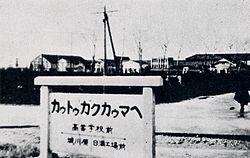This article needs additional citations for verification .(February 2023) |
 |
| Japanese writing |
|---|
| Components |
| Uses |
| Transliteration |
The kana orthography (正仮名遣い, sei kana-zukai ) in general use for writing the Japanese language until orthographic reforms after World War II is referred to as historical kana orthography ( 歴史的仮名遣い , rekishiteki kanazukai) or old orthography (旧仮名遣い, kyū kanazukai). The current orthography was adopted by Cabinet order in 1946. [1] By that point the historical orthography was no longer in accord with Japanese pronunciation. It differs from modern usage (現代仮名遣い, gendai kanazukai) in the number of characters and the way those characters are used. There was considerable opposition to the official adoption of the current orthography, on the grounds that the historical orthography conveys meanings better, and some writers continued to use it for many years after.
Contents
- General differences
- Examples
- Current usage
- Table of differences
- Table references
- Notes
- Romanization
- References
- External links
The historical orthography is found in almost all Japanese dictionaries, such as Kōjien . In the current edition of the Kōjien, if the historical orthography is different from the modern spelling, the old spelling is printed in tiny katakana between the modern kana and kanji transcriptions of the word. Ellipses are used to save space when the historical and modern spellings are identical. Older editions of the Kōjien gave priority to the historical orthography.
The historical orthography should not be confused with hentaigana , alternative kana that were declared obsolete with the orthographic reforms of 1900.

